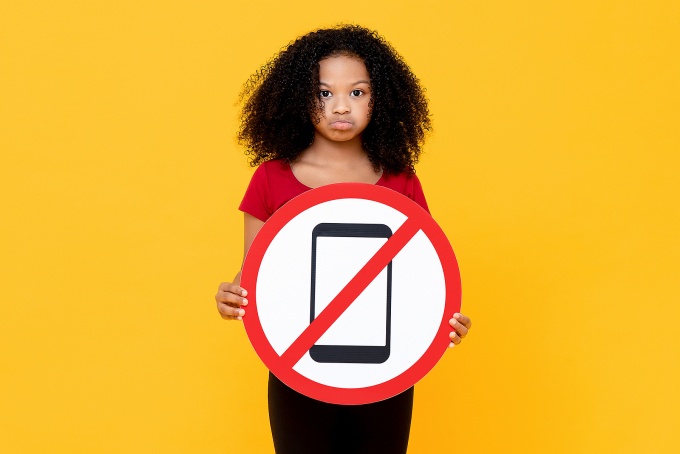No more school day scrolling

Release Date: August 13, 2025
BUFFALO, N.Y. - Aug. 1 marked the deadline for all publicly funded schools in New York to adopt a policy supporting the state’s "bell-to-bell" smart device restriction, approved as part of the state's annual budget.
The new policy restricts the use of smartphones, tablets, smartwatches or any other internet-connected personal device on school grounds from the first bell of the day to the last (bell-to-bell). But what does this mean for students, parents, teachers, administrators and school personnel?
We asked a panel of University at Buffalo experts from the Graduate School of Education to talk about what the new law entails, and what its implications might be. The panel consists of faculty members Stephanie Fredrick, Katheryne Leigh-Osroosh and Amanda Nickerson, and school psychology graduate student Sarah Woyken.
What exactly does the new law require of districts?
In addition to restricting smart devices, New York State now requires all districts, charter schools, and boards of cooperative services to develop a policy that:
- Permits schools to have flexibility in storing said devices, with $13.5 million of funding set aside to purchase device storage
- Provides parents/guardians a means to contact their children during the school day if needed
- Requires consultation with students, parents, and teachers in local policy formation
- Requires annual reporting of policy enforcement and disciplinary action
Are there any exemptions to the policy?
- For a specific educational purpose, school personnel, including teachers and principals, can authorize smart device use
- Use is permitted when required as part of a student’s Individualized Education Program (IEP), to manage a student’s health, for emergencies, for translation services, on a case-by-case basis as determined by a school psychologist/social worker/school counselor, or when deemed legally necessary
What are the perceived benefits and drawbacks of restricting smart devices “bell-to-bell?”
In implementing these restrictions, the rationale is to create a “distraction-free learning environment,” helping kids become less dependent on their phones and more in-tune with their surroundings during the school day. The state lists numerous benefits, ranging from academic and instructional (more efficient use of class time), to social-emotional and mental health-based (decreasing cyberbullying and increasing socialization). There are also a number of perceived educator benefits, such as less time spent monitoring phone use and better-quality interactions between students and teachers.
In addition to potential benefits, there are multiple concerns associated with implementing such a strict policy. Losing the ability to contact their children directly, parents are worried about student safety and communication in emergency situations. Infringing on student rights is an issue, particularly with the removal of a student’s smart device from their person. Restricting smart devices outright can also limit opportunities that infuse technology into instruction and teach students how to use smart devices responsibly.
What does the research say about smartphone restrictions in schools?
According to the state website created to assist with policy implementation, New York is the largest state by population to enact such restrictions. Statewide smart device restrictions are growing in popularity as it becomes evident that excessive phone use in youth is a growing problem. However, the effects of school smartphone restrictions, studied in other parts of the world, are less straightforward. In fact, most large-scale studies published within the last five years comparing strict and less-strict policies argued that stricter policies had no significant effect on students academically, and either minimal or non-significant improvements in measures like overall well-being or reduced bullying. Those in support of widespread restrictions tend to argue for bans using the former—studies that show effects of problematic use in youth—without citing the latter—the unclear or insignificant effects of blanket school restrictions. More rigorous research, including randomized controlled trials (RCTs), is needed to more effectively evaluate policy impacts. Based on current findings, schools are encouraged to consider additional factors—such as online safety, mental health, and bullying prevention programming—alongside smart device restrictions to support students’ social, emotional, and academic well-being.
What are the implications for the upcoming school year and beyond?
While many schools and districts already have policies in place, those previously allowing phones to be kept with students could experience the greatest immediate shift. However, for students struggling with this transition, it is important to note that those who violate the policy cannot be suspended strictly for failing to comply during the school day. The policy also states that students can keep non-internet-connected phones. Smart devices officially part of students’ learning, such as school-owned laptops, are also permitted. New York State has published a toolkit, as well as a list of frequently asked questions to guide schools in creating policies that comply with this new law and its exceptions.
Longer-term implications of this statewide policy are less clear. As Dr. Katheryne Leigh-Osroosh argues, simply restricting smart devices is not enough. The schools most successful in navigating this change in their technological landscape will be those that fill the cellphone void with innovative alternatives, perhaps through helping kids engage with each other face-to-face or by learning how to critically examine their media intake and online presence. Regardless of how schools and districts ultimately decide to implement their restrictions, only time will tell if this policy works the way it is intended to for students across the state.
Media Contact Information
Victoria (Vicky) Santos
News Content Manager/Content Developer
The Arts, Education
Tel: (716) 645-4613
vrsantos@buffalo.edu
